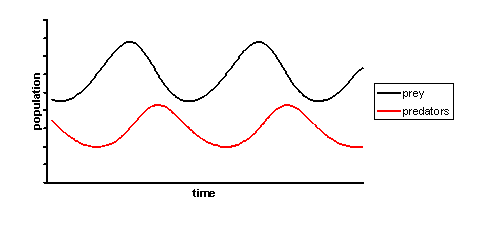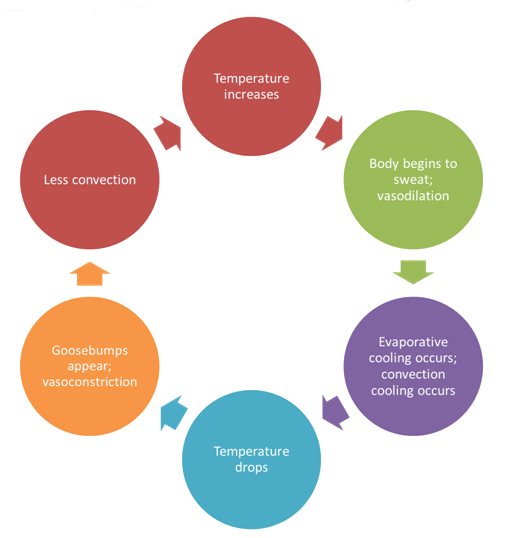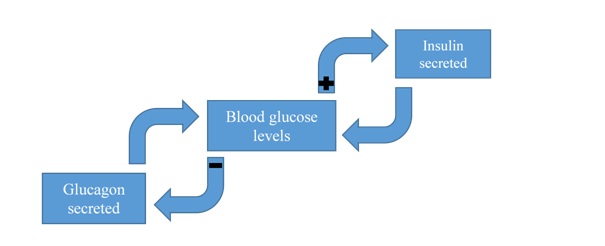Steps of the Negative Feed Back Loop
Feedback is defined as the information gained about a reaction to a product, which will allow the modification of the product. Feedback loops are therefore the process whereby a change to the system results in an alarm which will trigger a certain result. This result will either increase the change to the system or reduce it to bring the system back to normal. A few questions remain: How do these systems work? What is a positive feedback? What is negative feedback? Where do we find these systems in nature?
Biological systems operate on a mechanism of inputs and outputs, each caused by and causing a certain event. A feedback loop is a biological occurrence wherein the output of a system amplifies the system (positive feedback) or inhibits the system (negative feedback). Feedback loops are important because they allow living organisms to maintain homeostasis. Homeostasis is the mechanism that enables us to keep our internal environment relatively constant – not too hot, or too cold, not too hungry or tired. The level of energy that an organism needs to maintain homeostasis depends on the type of organism, as well as the environment it inhabits. For example, a cold-blooded fish keeps its temperature at the same level as the water around it, and so doesn't need to control its internal temperature. Compare this to a warm-blooded whale in the same environment: it needs to keep its body temperature higher than that of the water around it, and so it will expend more energy in temperature regulation. This is a difference between ectotherms and endotherms: an ectotherm uses the environmental temperature to control its internal temperature (e.g. reptiles, amphibians, and fish), whereas an endotherm uses homeostasis to maintain its internal temperature. Endotherms can maintain their metabolism at a constant rate, allowing constant movement, reaction and internal processes, whereas ectotherms cannot maintain their metabolism at a constant rate. This means that their movement, reaction and internal processes are dependent on adequate external heat, but it also means that they require less energy in the form of food, as their bodies are not constantly burning fuel.
Feedback loops can also occur to a larger degree: at the ecosystem level, a form of homeostasis is maintained. A good example of this is in the cycle of predator and prey populations: a boom in prey population will mean more food for predators, which will increase predator numbers. This will then lead to over predation, and the prey population will again decline. The predator population will decline in response, releasing the pressure on the prey population and allowing it to bounce back. See figure 1. Another example is what is known as the "evolutionary arms race," wherein a predator and its prey are continually trying to out compete each other. One such relationship is that of nectarivorous birds and the flowers on which they feed. The birds evolve long beaks to gain access to the nectar within the flower. In response, the flower develops a longer and longer trumpet-like shape, in an attempt at preventing the bird from getting to the nectar. The bird responds by developing an even longer beak. And so it continues.

Image Source: Wikimedia Commons
Figure 1: The population trends of predator and prey.
Positive Feedback Loops
A positive feedback loop occurs in nature when the product of a reaction leads to an increase in that reaction. If we look at a system in homeostasis, a positive feedback loop moves a system further away from the target of equilibrium. It does this by amplifying the effects of a product or event and occurs when something needs to happen quickly.
Example 1: Fruit Ripening
There is a surprising effect in nature where a tree or bush will suddenly ripen all of its fruit or vegetables, without any visible signal. This is our first example of a positive biological feedback loop. If we look at an apple tree, with many apples, seemingly overnight they all go from unripe to ripe to overripe. This will begin with the first apple to ripen. Once ripe, it gives off a gas known as ethylene (C2H4) through its skin. When exposed to this gas, the apples near to it also ripen. Once ripe, they too produce ethylene, which continues to ripen the rest of the tree in an effect much like a wave. This feedback loop is often used in fruit production, with apples being exposed to manufactured ethylene gas to make them ripen faster.

Figure 2: The process of apples ripening is a positive feedback loop.
Example 2: Childbirth
When labor begins, the baby's head is pushed downwards and results in increased pressure on the cervix. This stimulates receptor cells to send a chemical signal to the brain, allowing the release of oxytocin. This oxytocin diffuses to the cervix via the blood, where it stimulated further contractions. These contractions stimulate further oxytocin release until the baby is born.

Figure 3: The contractions experienced in childbirth come about as a result of a positive feedback loop.
Example 3: Blood Clotting
When tissue is torn or injured, a chemical is released. This chemical causes platelets in the blood to activate. Once these platelets have activated, they release a chemical which signals more platelets to activate, until the wound is clotted.

Figure 4: The process of wound clotting is a positive feedback loop.
Negative Feedback Loops
A negative feedback loop occurs in biology when the product of a reaction leads to a decrease in that reaction. In this way, a negative feedback loop brings a system closer to a target of stability or homeostasis. Negative feedback loops are responsible for the stabilization of a system, and ensure the maintenance of a steady, stable state. The response of the regulating mechanism is opposite to the output of the event.
Example 1: Temperature Regulation
Temperature regulation in humans occurs constantly. Normal human body temperature is approximately 98.6°F. When body temperature rises above this, two mechanisms kick in the body begins to sweat, and vasodilation occurs to allow more of the blood surface area to be exposed to the cooler external environment. As the sweat cools, it causes evaporative cooling, while the blood vessels cause convective cooling. Normal temperature is regained. Should these cooling mechanisms continue, the body will become cold. The mechanisms which then kick in are the formation of goose bumps, and vasoconstriction. Goosebumps in other mammals raise the hair or fur, allowing more heat to be retained. In humans, they tighten the surrounding skin, reducing (slightly) the surface area from which to lose heat. Vasoconstriction ensures that only a small surface area of the veins is exposed to the cooler outside temperature, retaining heat. Normal temperature is regained.

Figure 5: The process of temperature regulation in humans is a negative feedback loop.
Example 2: Blood Pressure Regulation (Baroreflex)
Blood pressure needs to remain high enough to pump blood to all parts of the body, but not so high as to cause damage while doing so. While the heart is pumping, baroreceptors detect the pressure of the blood going through the arteries. If the pressure is too high or too low, a chemical signal is sent to the brain via the glossopharyngeal nerve. The brain then sends a chemical signal to the heart to adjust the rate of pumping: if blood pressure is low, heart rate increases, while if blood pressure is high, heart rate decreases.
Example 3: Osmoregulation
Osmoregulation refers to the control of the concentration of various liquids within the body, to maintain homeostasis. We will again look at an example of a fish, living in the ocean. The concentration of salt in the water surrounding the fish is much higher than that of the liquid in the fish. This water enters the fish diffusion through the gills, through food consumption, and through drinking. Also, because the concentration of salt is higher outside than inside the fish, there is passive diffusion of salt into the fish and water out of the fish. The salt concentration is then too high in the fish, and salt ions must be released through excretion. This occurs via the skin, and in very concentrated urine. In addition, high salt levels in the blood are removed via active transport by the chloride secretory cells in the gills. The correct salt concentration is thus maintained.

Figure 6: The process of osmoregulation in saltwater fish is a constant negative feedback loop.
Positive vs. Negative Feedback
The key difference between positive and negative feedback is their response to change: positive feedback amplifies change while negative feedback reduces change. This means that positive feedback will result in more of a product: more apples, more contractions, or more clotting platelets. Negative feedback will result in less of a product: less heat, less pressure, or less salt. Positive feedback moves away from a target point while negative feedback moves towards a target.
Why is Feedback Important?
Without feedback, homeostasis cannot occur. This means that an organism loses the ability to self-regulate its body. Negative feedback mechanisms are more common in homeostasis, but positive feedback loops are also important. Changes in feedback loops can lead to various issues, including diabetes mellitus.

Figure 7: In a normal glucose cycle, increases in blood glucose levels detected by the pancreas will result in the beta cells of the pancreas secreting insulin until normal blood glucose levels are reached. Whereas if low blood glucose levels are detected, the alpha cells of the pancreas will release glucagon to raise blood glucose levels to be normal.
In type 1 diabetes, beta cells don't work. This means that when blood glucose levels rise, insulin production is not triggered, and so blood glucose levels continue to go up. This can result in symptoms such as blurred vision, weight loss, hyperventilation, nausea and vomiting, among others. In type 2 diabetes, chronic high blood glucose levels have occurred as a result of poor diet and lack of exercise. This results in cells no longer recognizing insulin, and so blood glucose levels continue to rise.
Wrapping Up Positive and Negative Feedback Loops
Feedback loops are biological mechanisms whereby homeostasis is maintained. This occurs when the product or output of an event or reaction changes the organism's response to that reaction. Positive feedback occurs to increase the change or output: the result of a reaction is amplified to make it occur more quickly. Negative feedback occurs to reduce the change or output: the result of a reaction is reduced to bring the system back to a stable state. Some examples of positive feedback are contractions in child birth and the ripening of fruit; negative feedback examples include the regulation of blood glucose levels and osmoregulation.
Looking for Biology practice?
Kickstart your Biology prep with Albert. Start your AP® exam prep today.
Source: https://www.albert.io/blog/positive-negative-feedback-loops-biology/
0 Response to "Steps of the Negative Feed Back Loop"
Post a Comment